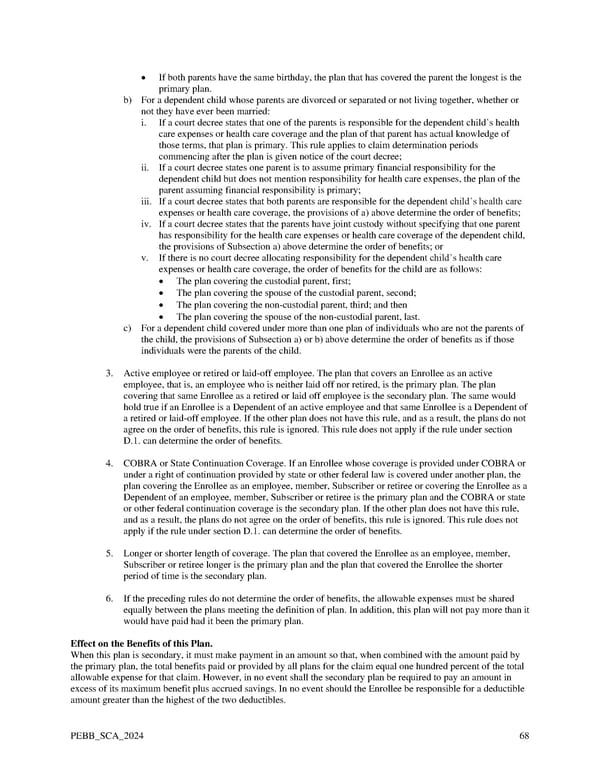• If both parents have the same birthday, the plan that has covered the parent the longest is the primary plan. b) For a dependent child whose parents are divorced or separated or not living together, whether or not they have ever been married: i. If a court decree states that one of the parents is responsible for the dependent child’s health care expenses or health care coverage and the plan of that parent has actual knowledge of those terms, that plan is primary. This rule applies to claim determination periods commencing after the plan is given notice of the court decree; ii. If a court decree states one parent is to assume primary financial responsibility for the dependent child but does not mention responsibility for health care expenses, the plan of the parent assuming financial responsibility is primary; iii. If a court decree states that both parents are responsible for the dependent child’s health care expenses or health care coverage, the provisions of a) above determine the order of benefits; iv. If a court decree states that the parents have joint custody without specifying that one parent has responsibility for the health care expenses or health care coverage of the dependent child, the provisions of Subsection a) above determine the order of benefits; or v. If there is no court decree allocating responsibility for the dependent child’s health care expenses or health care coverage, the order of benefits for the child are as follows: • The plan covering the custodial parent, first; • The plan covering the spouse of the custodial parent, second; • The plan covering the non-custodial parent, third; and then • The plan covering the spouse of the non-custodial parent, last. c) For a dependent child covered under more than one plan of individuals who are not the parents of the child, the provisions of Subsection a) or b) above determine the order of benefits as if those individuals were the parents of the child. 3. Active employee or retired or laid-off employee. The plan that covers an Enrollee as an active employee, that is, an employee who is neither laid off nor retired, is the primary plan. The plan covering that same Enrollee as a retired or laid off employee is the secondary plan. The same would hold true if an Enrollee is a Dependent of an active employee and that same Enrollee is a Dependent of a retired or laid-off employee. If the other plan does not have this rule, and as a result, the plans do not agree on the order of benefits, this rule is ignored. This rule does not apply if the rule under section D.1. can determine the order of benefits. 4. COBRA or State Continuation Coverage. If an Enrollee whose coverage is provided under COBRA or under a right of continuation provided by state or other federal law is covered under another plan, the plan covering the Enrollee as an employee, member, Subscriber or retiree or covering the Enrollee as a Dependent of an employee, member, Subscriber or retiree is the primary plan and the COBRA or state or other federal continuation coverage is the secondary plan. If the other plan does not have this rule, and as a result, the plans do not agree on the order of benefits, this rule is ignored. This rule does not apply if the rule under section D.1. can determine the order of benefits. 5. Longer or shorter length of coverage. The plan that covered the Enrollee as an employee, member, Subscriber or retiree longer is the primary plan and the plan that covered the Enrollee the shorter period of time is the secondary plan. 6. If the preceding rules do not determine the order of benefits, the allowable expenses must be shared equally between the plans meeting the definition of plan. In addition, this plan will not pay more than it would have paid had it been the primary plan. Effect on the Benefits of this Plan. When this plan is secondary, it must make payment in an amount so that, when combined with the amount paid by the primary plan, the total benefits paid or provided by all plans for the claim equal one hundred percent of the total allowable expense for that claim. However, in no event shall the secondary plan be required to pay an amount in excess of its maximum benefit plus accrued savings. In no event should the Enrollee be responsible for a deductible amount greater than the highest of the two deductibles. PEBB_SCA_2024 68
 Kaiser Permanente WA SoundChoice EOC (2024) Page 67 Page 69
Kaiser Permanente WA SoundChoice EOC (2024) Page 67 Page 69